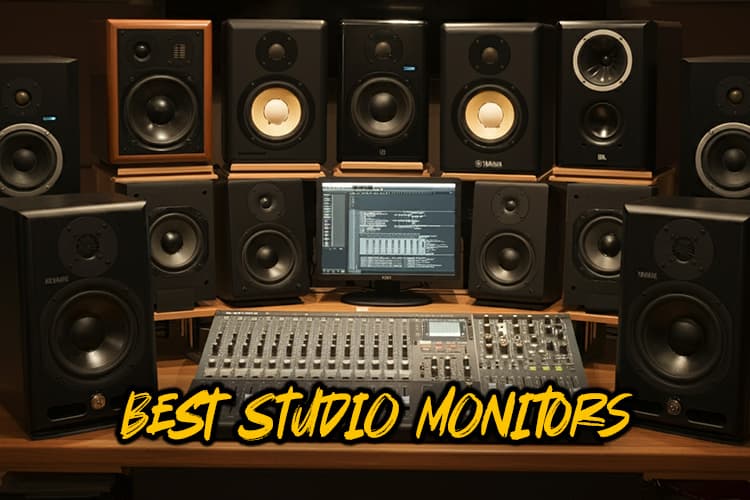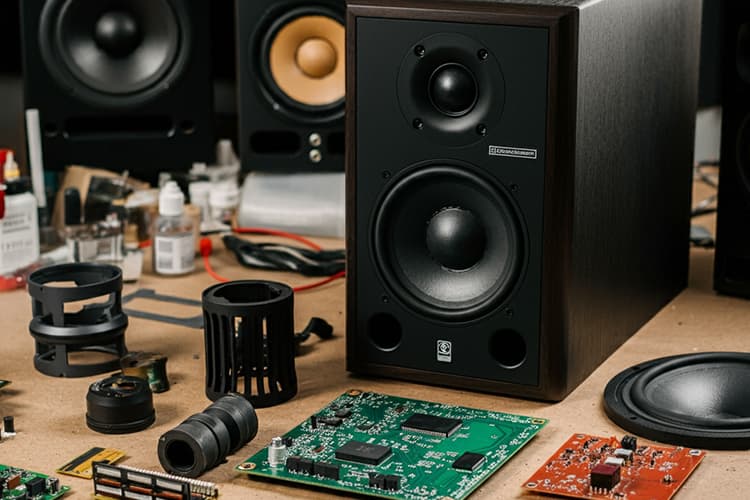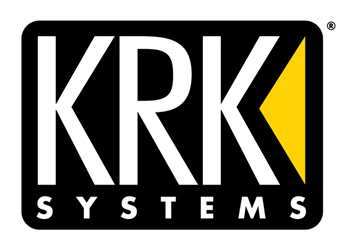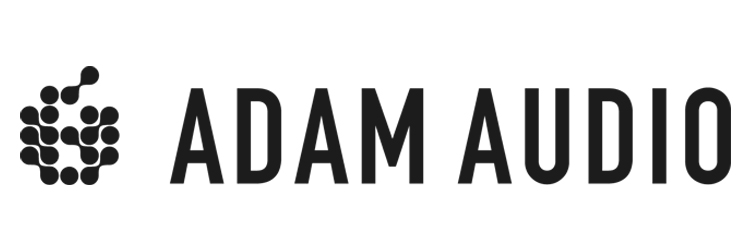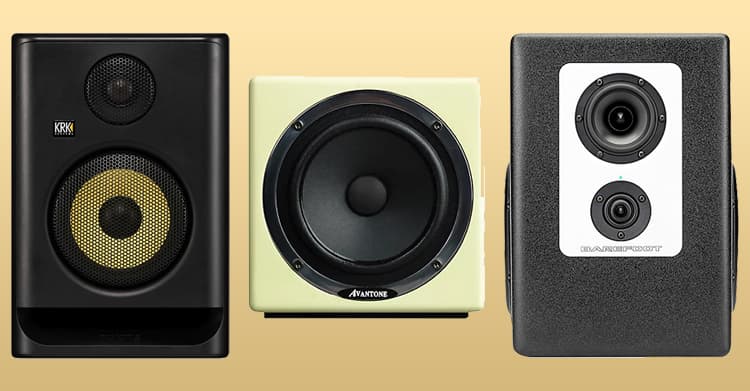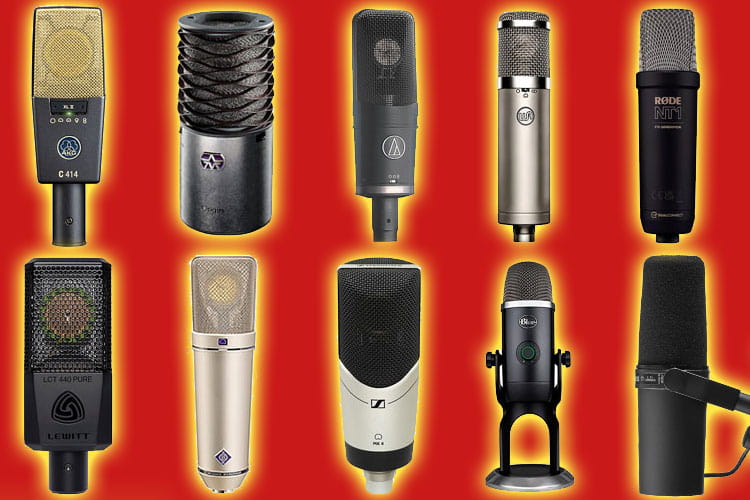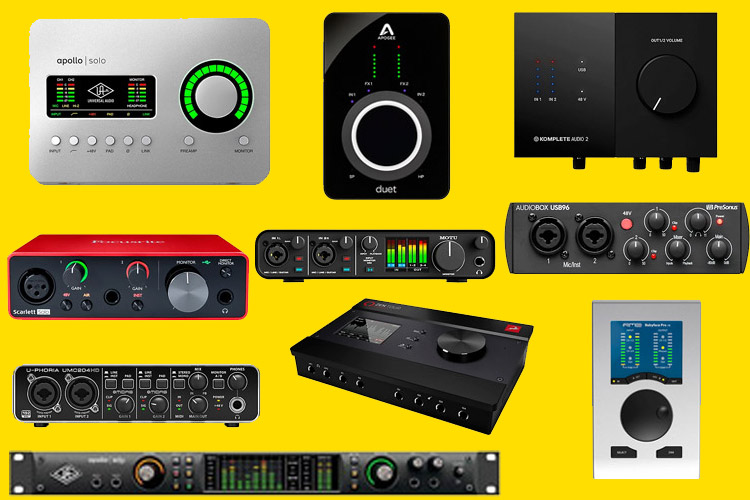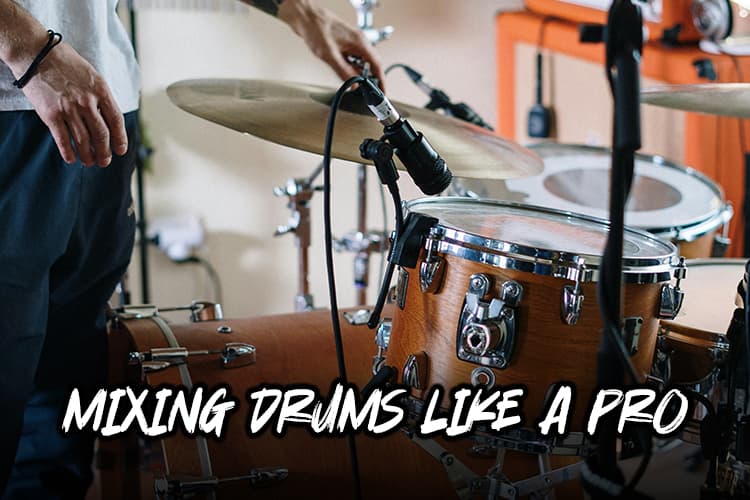Are you ready to take your audio production to the next level? Well, you’re in for a treat!
Finding the best studio monitors can be a game-changer for your music, podcasts, or video projects.
Professional audio engineers consider studio monitors the most crucial piece of equipment in their setup.
That’s right – if you want to learn how to mix music like a pro your choice of monitors can make or break your sound quality.
In this guide, we’ll dive into the world of studio monitors, helping you navigate the sea of options to find the perfect pair for your needs and budget.
Let’s get started on your journey to audio perfection!
Understanding Studio Monitors: The Backbone of Professional Audio
Let me tell you, when I first started dabbling in music production, I had no clue what studio monitors were.
I thought my trusty old computer speakers would do the trick. Boy, was I wrong!
It wasn’t until I saw a friend’s home studio setup that I realized what I was missing out on.
Studio monitors are like the secret sauce of professional audio and can be some of the best music production equipment you invest in.
They’re specially designed speakers that give you an accurate, uncolored representation of your sound.
Unlike regular speakers that might boost certain frequencies to sound “nice,” studio monitors tell it like it is.
It’s like the difference between a friend who always tells you what you want to hear and one who gives you honest feedback.
Sometimes it’s brutal, but it’s what you need to improve.
I remember the first time I mixed a track on proper studio monitors. It was like putting on glasses after squinting at the world for years.
Suddenly, I could hear all these details I’d been missing. The clarity was mind-blowing!
But it also meant I had to face the hard truth about my mixing skills (or lack thereof).
When you’re looking for good studio monitors, there are a few key things to keep an eye out for:
- Flat frequency response (you want the truth, not a sugar-coated version of your mix)
- Low distortion (because who wants their audio to sound like it’s coming through a broken radio?)
- Accurate stereo imaging (so you can place those instruments just right in the mix)
- Good transient response (to catch those quick drum hits and plucky sounds)
These features might sound techy, but trust me, they make a world of difference in your production game.
The impact of studio monitors on your audio production can’t be overstated.
They’re like the foundation of a house – if it’s shaky, everything built on top of it is gonna be wonky.
With good monitors, you can make informed decisions about EQ, balance, and effects. Without them, you’re basically mixing with a blindfold on.
I learned this the hard way when I was learning how to mix drums on cheap speakers.
It sounded great in my room, but when I played it in my car? Yikes!
The bass was way too heavy, and the tracks were practically inaudible.
That’s when I realized that investing in proper studio monitors wasn’t just a luxury – it was a necessity if I wanted to create a professional-sound.
But here’s the thing: studio monitors aren’t just for professional producers in fancy studios.
Even if you’re just starting out or working in a small home setup, a decent pair of monitors can make a huge difference.
They’ll help you develop your ear and make better mixing decisions from the get-go.
So, if you’re serious about audio production, do yourself a favor and invest in some good studio monitors.
Your ears (and your future listeners) will thank you!
Best Budget Studio Monitors Under $500
1. PreSonus Eris Studio 5
Features:
- 5.25″ woven composite woofer
- 1″ silk-dome tweeter
- 80W Class AB bi-amplification
- Front-firing bass port
- Acoustic tuning controls
Pros:
- Excellent clarity and definition in the midrange
- Surprisingly deep bass response for its size
- Wide sweet spot thanks to EBM waveguide
- Affordable price point
Cons:
- Highs can be a bit harsh at high volumes
- Some users report a slight hum in quiet environments
2. JBL 305P MkII
Features:
- 5″ woofer with JBL’s Image Control Waveguide
- 1″ soft-dome tweeter
- 82W Class D amplification
- Dual-port design for extended bass response
- Boundary EQ and HF trim controls
Pros:
- Impressive soundstage and imaging
- Neutral, balanced sound across the frequency spectrum
- Compact size ideal for smaller studios
- Robust build quality
Cons:
- Bass can be a bit boomy in untreated rooms
- Some users find the power LED too bright
3. Yamaha HS5
Features:
- 5″ cone woofer
- 1″ dome tweeter
- 70W total power output
- Room control and high trim response controls
- Iconic white cone design
Pros:
- Flat, honest response – great for critical listening
- Excellent transient response and detail retrieval
- Compact and visually striking design
- Low fatigue during long mixing sessions
Cons:
- Limited bass extension due to small woofer size
- Can sound somewhat clinical to some ears
4. Kali Audio LP-6 V2
Features:
- 6.5″ woofer with low-noise port tube
- 1″ soft-dome tweeter
- 80W Class D bi-amplification
- Boundary EQ settings
- Optional waveguide for improved imaging
Pros:
- Exceptionally flat frequency response
- Impressive low-end for the price point
- Wide sweet spot and excellent imaging
- Helpful boundary compensation settings
Cons:
- Some users report quality control issues
- Larger size may not suit very small spaces
5. Adam Audio T5V
Features:
- 5″ woofer
- U-ART (Unique Accelerated Ribbon Tweeter)
- 70W total power output
- Rear-firing bass port
- HF adjustment switch
Pros:
- Exceptional high-frequency detail and air
- Tight, controlled bass response
- Wide dispersion for a larger sweet spot
- Sleek, modern design
Cons:
- Midrange can be slightly recessed
- Some users find them fatiguing during long sessions
Best High-End Studio Monitors
1. Genelec 8351B
Features:
- Coaxial midrange/tweeter with dual 8.5″ woofers
- 500W tri-amplified system
- Genelec GLM calibration system
- Proprietary Acoustically Concealed Woofers (ACW)
- Precision die-cast aluminum enclosure
Pros:
- Unparalleled accuracy and neutrality
- Incredibly wide and deep soundstage
- Adaptive room correction via GLM
- Exceptional build quality and longevity
Cons:
- Eye-watering price tag
- Requires proper room treatment for optimal performance
- Learning curve with GLM system
2. Neumann KH 420
Features:
- 10″ woofer, 3″ midrange driver, 1″ tweeter
- 330W tri-amplified system
- Mathematically modeled dispersion
- Flexible acoustical controls
- Made in Germany with stringent quality control
Pros:
- Exceptionally flat frequency response
- Incredible clarity and detail across all frequencies
- Effortless handling of complex mixes
- Rock-solid imaging and depth
Cons:
- Substantial size and weight
- Significant investment
- May be overkill for smaller studios
3. Focal Trio11 Be
Features:
- 10″ “W” composite sandwich cone woofer
- 5″ “W” midrange driver
- 1″ pure Beryllium inverted dome tweeter
- 550W tri-amplified system
- Focus mode for near-field listening
Pros:
- Astounding midrange clarity and presence
- Powerful, controlled bass response
- Unique focus mode for checking mixes in near-field
- Stunning dynamic range and transient response
Cons:
- Requires a large, well-treated room
- Significant learning curve to fully utilize
- Premium price point
4. ATC SCM100ASL Pro
Features:
- 12″ Super Linear woofer
- 3″ soft dome midrange
- 1″ tweeter
- 350W tri-amplified system
- Heavily braced, curved cabinet design
Pros:
- Legendary midrange performance
- Exceptional dynamic range and headroom
- Uncolored, brutally honest sound reproduction
- Built like a tank for decades of use
Cons:
- Extremely heavy and difficult to move
- Requires a very large listening space
- Can be unforgiving with poor recordings
5. Dutch & Dutch 8c
Features:
- 8″ woofer with cardioid bass response
- Dual 8″ rear-mounted subwoofers
- 1″ waveguide-loaded tweeter
- DSP-controlled crossover and room correction
- Sealed cabinet design
Pros:
- Revolutionary cardioid bass for reduced room interaction
- Incredibly deep, controlled bass from a compact cabinet
- Built-in DSP for precise room tuning
- Holographic soundstage and imaging
Cons:
- Cutting-edge design may not suit traditionalists
- Reliance on DSP may not appeal to analog purists
- Premium price reflects innovative technology
Best Studio Monitors Comparison
| Name | Price Range | Pros | Cons |
|---|---|---|---|
PreSonus Eris E5 XT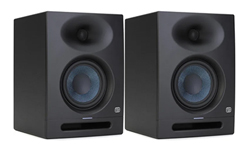 | Under $500 PURCHASE |
|
|
JBL 305P MkII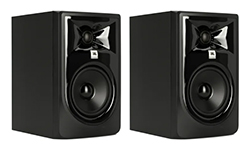 | Under $500 PURCHASE |
|
|
Yamaha HS5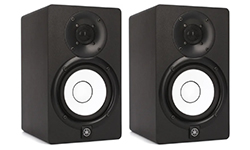 | Under $500 PURCHASE |
|
|
Kali Audio LP-6 V2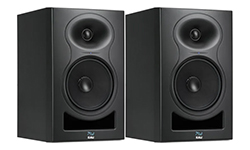 | Under $500 PURCHASE |
|
|
Adam Audio T5V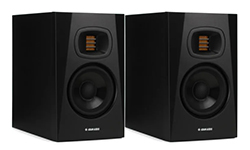 | Under $500 PURCHASE |
|
|
Genelec 8351B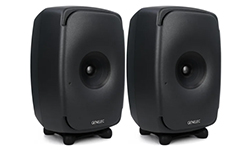 | High-End PURCHASE |
|
|
Neumann KH 420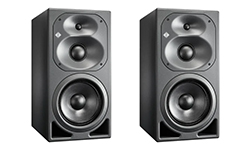 | High-End PURCHASE |
|
|
Focal Trio11 Be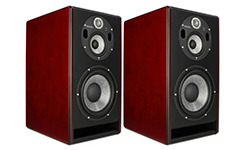 | High-End PURCHASE |
|
|
ATC SCM100ASL Pro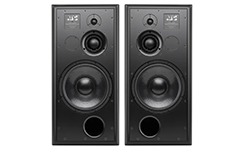 | High-End PURCHASE |
|
|
Dutch & Dutch 8c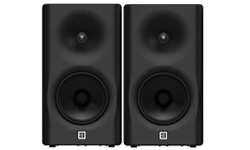 | High-End PURCHASE |
|
|
Best Studio Monitor Brands in 2024
Alright, let’s talk about the big players in the studio monitor game.
When I first started looking into monitors, the sheer number of brands out there made my head spin.
But over time, I’ve come to know and love (or sometimes love to hate) some of the top dogs in the industry.
Yamaha
First up, we’ve got Yamaha. These guys have been around forever, and for good reason.
Their NS10s were like the industry standard back in the day, and they’re still killing it with their HS series.
I remember the first time I heard a pair of HS8s – it was like someone had cleaned my ears out with a Q-tip made of pure audio clarity.
KRK
Then there’s KRK, with their iconic yellow cones.
These were my first “real” monitors, and I’ve got a soft spot for them.
They’re known for being a bit bass-heavy, which can be great for certain genres.
Just be careful not to get too addicted to that low end – it can be deceiving!
Adam Audio
Adam Audio is another heavy hitter. Their ribbon tweeters are something special, lemme tell ya.
The first time I heard a pair of Adam A7Xs, I swear I could hear sounds I’d never noticed before in songs I’d listened to a million times.
Genelec and Neumann
For the high-end stuff, you’ve got brands like Genelec and Neumann.
These are the kind of monitors that make you want to sell a kidney to afford them. But man, the sound quality is out of this world.
I once had the chance to mix on a pair of Genelecs in a pro studio, and it ruined me for a while.
Going back to my own setup was like downgrading from a Ferrari to a bicycle.
PreSonus and JBL
On the more budget-friendly side, you’ve got brands like PreSonus and JBL.
These guys are doing great things for home studio enthusiasts who don’t want to break the bank.
I’ve been impressed with how good some of their entry-level monitors sound.
When it comes to price ranges, you’re looking at anywhere from about $300 for a decent entry-level pair up to several thousand for the top-of-the-line stuff.
It’s easy to get caught up in the “more expensive must be better” mindset, but trust me, there are some great options at every price point.
The key is to find the monitors that work best for your specific needs and budget.
Don’t feel like you need to remortgage your house to get started. I’ve heard some killer mixes come out of modest setups with mid-range monitors.
One thing to keep in mind is that different brands often have different “flavors” to their sound.
Some lean towards a brighter top end, others might have a bit more presence in the mids.
It’s worth trying out a few different options if you can, to see what suits your ears and your mixing style best.
I remember when I was shopping for my current monitors, I spent weeks agonizing over specs and reviews.
In the end, I went to a music store and spent an afternoon listening to different pairs.
It was the best decision I could’ve made. There’s no substitute for hearing them with your own ears.
So, whether you’re just starting out or looking to upgrade, there’s a monitor brand out there that’s perfect for you.
Don’t be afraid to explore and find your perfect match. Who knows, you might even end up with a pair that becomes your new best friend in the studio!
Choosing the Right Size: From Compact to Full-Range Monitors
Okay, let’s talk about monitor sizes. This is one of those topics that can get real confusing, real fast.
When I first started out, I thought bigger was always better. Boy, was I in for a surprise!
Studio Monitor Size
Monitor sizes typically range from tiny 3-inch drivers all the way up to massive 8-inch (or even larger) woofers.
Each size has its own pros and cons, and choosing the right one depends on a bunch of factors.
3 Inch and 4 Inch Studio Monitors
Let’s start with the lil’ guys – 3-inch and 4-inch monitors.
These compact speakers are great for small spaces or desktop setups.
They’re also perfect for checking how your mix translates to smaller speakers (think laptop or phone speakers).
I’ve got a pair of 3-inch monitors that I use as a secondary reference, and they’ve saved my bacon more than once when it comes to making sure my mix sounds good on all systems.
5 Inch Studio Monitors
Moving up to 5-inch monitors, you’re getting into the sweet spot for many home studios.
These bad boys offer a good balance between size and performance.
They’re small enough to fit in most rooms but big enough to give you a decent amount of low-end response.
I used 5-inch monitors for years in my apartment studio, and they served me well.
6.5 Inch and 8 Inch Studio Monitors
Now, 6.5-inch and 8-inch monitors are where things start to get serious.
These larger speakers can reproduce lower frequencies more accurately, which is crucial for genres that rely heavily on bass.
But here’s the catch – they also need more space to breathe.
I learned this the hard way when I upgraded to 8-inch monitors in my small bedroom studio.
The bass was overwhelming and boomy because the speakers were too close to the walls.
When it comes to matching monitor size to your room and mixing needs, here are a few things to consider:
- Room size: Bigger rooms can handle larger monitors without issues.
- Genre: Bass-heavy music might benefit from larger drivers.
- Listening distance: Larger monitors are better for greater distances.
- Budget: Generally, larger monitors cost more.
For different studio setups, here are some quick recommendations:
- Bedroom studio: 5-inch or 6.5-inch monitors are usually a safe bet.
- Small professional studio: 6.5-inch or 8-inch monitors can work well.
- Large commercial studio: 8-inch or larger, possibly with a subwoofer.
Remember, these are just guidelines. I’ve heard amazing mixes come out of tiny monitors, and I’ve also heard terrible mixes from expensive setups.
It’s all about knowing your gear and your room.
One mistake I made early on was assuming that bigger monitors would automatically make my mixes better.
I splurged on a pair of 8-inch monitors for my tiny bedroom studio, thinking they’d be a game-changer.
Instead, they caused more problems than they solved.
The bass was overwhelming in my small space, and it took me ages to learn how to mix accurately on them and I also needed to do some DIY studio soundproofing.
The key is to choose monitors that fit your space and your needs.
Don’t be afraid to go for smaller monitors if that’s what suits your room best.
You can always add a subwoofer later if you need more low-end extension.
Pro Tip: Whatever size you choose, make sure to treat your room acoustically. Even the best monitors in the world won’t sound good in a room with bad acoustics. Trust me, I learned this lesson the hard way!
So, whether you’re mixing in a closet or a cathedral, there’s a monitor size out there that’s perfect for you.
Just remember, bigger isn’t always better – it’s all about finding the right fit for your unique situation.
Happy monitor hunting!
Active vs. Passive Studio Monitors: Which is Right for You?
Alright, let’s dive into the age-old debate of active vs. passive studio monitors.
This is one of those topics that can spark heated discussions among audio nerds (trust me, I’ve been in the middle of a few).
First things first, let’s break down what these terms actually mean.
Active monitors have built-in amplifiers, while passive monitors require an external amp to function.
Sounds simple enough, right? Well, it gets a bit more complicated when you start looking at the pros and cons of each.
I remember when I first started out, I was all about passive monitors.
I thought, “Hey, I can upgrade the amp separately and have more control!”
But then I actually tried to set up a passive system, and boy, was it a headache.
Matching the amp to the speakers, dealing with extra cables… it was like trying to solve a puzzle with half the pieces missing.
Active monitors, on the other hand, are like the “plug and play” option of the monitor world.
You just connect them to your audio interface, and you’re good to go.
Plus, the amplifiers are specifically matched to the speakers, which can result in better overall performance.
Here’s a quick rundown of the advantages and disadvantages of each type:
Active Studio Monitors:
- Pros: Easier setup, matched amp and speakers, often more accurate sound
- Cons: Can be more expensive, less flexibility for upgrades
Passive Studio Monitors:
- Pros: More flexibility for upgrades, potentially cheaper initial cost
- Cons: More complex setup, need to match amp and speakers carefully
When it comes to choosing between active and passive, there are a few things to consider.
If you’re just starting out or you want a simpler setup, active monitors are probably the way to go.
They’re easier to use and you don’t have to worry about matching components.
On the other hand, if you’re an audio tinkerer who loves to tweak and upgrade your gear, passive monitors might be more up your alley.
Just be prepared for a bit more work on the setup side.
In terms of popular models, you’ve got tons of options in both categories.
For active monitors, the Yamaha HS series and KRK Rokit line are super popular (and for good reason).
On the passive side, you might look at something like the Avantone MixCubes or some of the higher-end ATC models.
I gotta say, after years of experimenting with both types, I’ve become a big fan of active monitors for most situations.
The convenience factor is huge, and the sound quality of modern active monitors is pretty darn impressive.
But here’s the thing – at the end of the day, the most important factor is how the monitors sound to you.
I’ve heard incredible mixes come out of both active and passive setups.
It’s all about finding what works best for your ears and your workflow.
I remember one time I was working on a mix in a studio with a pair of high-end passive monitors.
They sounded amazing, but I spent half the session fiddling with the amp settings trying to get things just right.
Meanwhile, my buddy was cranking out great mixes on his active monitors without breaking a sweat.
So, whether you go active or passive, the key is to choose monitors that you enjoy listening to and that help you make good mixing decisions.
Don’t get too caught up in the technical details – focus on what helps you make great music.
And remember, the best monitors are the ones you know inside and out!
Key Technical Specifications to Consider
Alright, buckle up folks, ’cause we’re about to get a little techy here.
But don’t worry, I’ll try to keep it as painless as possible.
When I first started looking at monitor specs, it felt like I was trying to decipher an alien language.
But trust me, understanding these specs can make a huge difference in choosing the right monitors for your needs.
Frequency Response
First up, let’s talk about frequency response.
This is basically the range of frequencies that the monitor can reproduce, usually measured in Hertz (Hz).
You’ll often see something like “45Hz – 20kHz” in the specs.
The lower number represents the bass response, while the higher number is the treble limit.
Now, you might think, “The wider the range, the better, right?” Well, not necessarily.
I once bought a pair of monitors boasting an impressively wide frequency range, only to find out that they had a massive dip in the mid-range, making it really hard to mix vocals accurately.
The key is to look for a flat frequency response across the range, rather than just focusing on the extremes.
Power Output
Next up, we’ve got power output. This is measured in watts and tells you how loud the monitors can get.
But here’s the thing – more power doesn’t always mean better sound.
I’ve used 50-watt monitors that sounded clearer and more detailed than some 100-watt models.
It’s all about how that power is used.
That said, having some headroom in terms of power can be useful, especially if you’re working in a larger space or if you like to crank it up occasionally (just remember to protect your ears, kids!).
Total Harmonic Distortion
Now, let’s talk about Total Harmonic Distortion (THD).
This is a measure of how much the monitor distorts the original signal. Lower is generally better here.
I once used a pair of monitors with high THD, and let me tell you, it was not fun.
Everything sounded slightly “fuzzy,” and it made it really hard to make accurate mixing decisions.
Look for monitors with THD ratings below 1% – the lower, the better.
But don’t get too hung up on tiny differences.
The difference between 0.05% and 0.01% THD is probably not going to be noticeable to most ears.
Crossover Frequency
Lastly, we’ve got crossover frequency. This is the point at which the signal is split between the woofer (for low frequencies) and the tweeter (for high frequencies).
It’s important because a poorly designed crossover can lead to phase issues and inconsistencies in the sound.
I remember working on a pair of monitors with a poorly implemented crossover.
There was this weird “hole” in the frequency response right around the crossover point, which made certain instruments sound really strange.
It took me ages to figure out what was going on!
When looking at crossover specs, pay attention to how steep the crossover slope is (measured in dB/octave) and where the crossover point is set.
A good crossover should create a seamless transition between the woofer and tweeter.
Here’s a quick summary of what to look for:
- Frequency Response: As flat as possible across the range
- Power Output: Enough for your space, but don’t obsess over high numbers
- THD: Lower is better, aim for under 1%
- Crossover: Look for a well-designed system with a smooth transition
Remember, these specs are just part of the picture. Nothing beats actually listening to the monitors in person.
I’ve seen monitors with great specs on paper that just didn’t sound good to my ears, and vice versa.
The most important thing is to choose monitors that help you make good mixing decisions.
All the fancy specs in the world don’t matter if you can’t create great-sounding mixes on them and don’t know how to produce music.
So use these specs as a guide, but trust your ears above all else!
Final Thoughts on the Best Studio Monitors
Whew! We’ve covered a lot of ground in our quest for the best studio monitors of 2024.
From understanding the basics to exploring top brands and technical specifications, you’re now armed with the knowledge to make an informed decision.
Remember, the perfect monitors for you will depend on your specific needs, room size, and budget.
Don’t be afraid to test out different options and trust your ears – after all, they’re your most valuable tool in this journey.
Ready to elevate your audio game? Go forth and find your ideal studio monitors.
Your future masterpieces are waiting to be heard in all their crystal-clear glory!

